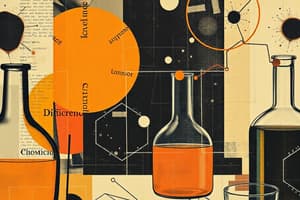Podcast
Questions and Answers
What is the main characteristic of elements in nature?
What is the main characteristic of elements in nature?
- They are always found in compounds
- They can be broken down into simpler substances
- They are only found in laboratories
- They are usually found as single atoms (correct)
What is the most abundant element found in our world?
What is the most abundant element found in our world?
- Hydrogen (correct)
- Iron
- Gold
- Oxygen
Why is the answer to whether our surrounding matter is pure a resounding 'no'?
Why is the answer to whether our surrounding matter is pure a resounding 'no'?
- Because pure elements are abundant in nature
- Because pure substances are not present in our surroundings (correct)
- Because elements cannot form compounds
- Because even the purest element like gold is found as a compound
Which best describes a mixture?
Which best describes a mixture?
What type of bond usually forms compounds?
What type of bond usually forms compounds?
How can mixtures be separated?
How can mixtures be separated?
Which of the following is an element?
Which of the following is an element?
Flashcards are hidden until you start studying
Study Notes
Is Our Surrounding Matter Pure?
Delve into the atomic world of substances, and you'll find that our everyday materials aren't quite as simple as you might think. In fact, they're far from pure. To grasp this concept, let's dissect the basics of mixtures, compounds, and elements.
Mixtures
When we talk about mixtures, we're referring to substances that are physically combined but do not form new chemical bonds. Think of a mixture like a bag of skittles, where the individual candies are in close contact but still distinctly separate. Mixtures can be homogeneous (uniform throughout, like salt dissolved in water) or heterogeneous (visible layers or components, like sand and water). Mixtures are often formed by combining elements or compounds, and they can always be separated through physical means like filtering or evaporation.
Compounds
Compounds, on the other hand, are formed when two or more elements bond chemically. These bonds are usually covalent, although ionic and metallic bonds can also create compounds. Compounds have specific compositions and properties that are usually different from those of their individual elements. For example, water (H2O) is a compound formed by one atom of oxygen and two atoms of hydrogen. Compounds are not typically separated using physical methods alone because the chemical bonding requires energy input, like heat or electricity, to break them apart.
Elements
Elements are the fundamental building blocks of matter. There are 118 known elements, and they cannot be broken down into simpler substances through ordinary chemical methods. Elements are usually found in nature as single atoms, but they can also be combined to form compounds. The most abundant elements in our world are hydrogen, oxygen, carbon, and nitrogen.
Pure Materials
So, when we wonder if our surrounding matter is pure, we must understand that the answer is a resounding "no." The air we breathe, the water we drink, and the materials we touch are almost always mixtures and compounds. Even the purest element, like gold, is not found in its elemental form in nature.
In summary, our surroundings are not a sea of pure substances. Instead, they are a complex world of mixtures and compounds, formed by elements that interact chemically and physically. Understanding these basic concepts will help you better appreciate the fascinating world of chemistry and materials science.
Studying That Suits You
Use AI to generate personalized quizzes and flashcards to suit your learning preferences.




